The C’nature conference: what future climate for New Caledonia?
Christophe Menkès and Alexandre Peltier, respectively a climatologist and co-coordinator of CLIPSSA, and a meteorologist in charge of climate at Meteo-France‘s inter-regional office in New Caledonia and Wallis and Futuna, presented their work to the public at the C’nature conference on April 1, 2025. The conference, organized by CRESICA at the Province Sud auditorium, was attended by 110 participants.
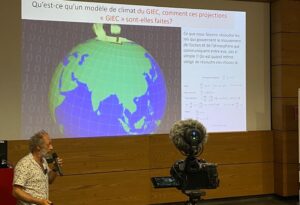
Christophe Menkès at the C’nature conference, 04/01/2025, © Cléophée Montizon
New Caledonia’s past climate
Alexandre Peltier presented the methods used to measure recent climatic changes in New Caledonia. Every day, meteorologists check the readings from temperature and precipitation stations. Access to historical data is necessary to monitor long-term climate trends. Analysis of this data shows an average rise in New Caledonia’s climate of 1.3°C since 1965 and an increase in the frequency of heatwave episodes.
On the other hand, precipitation fluctuates due to the oscillation between El Niño and La Niña, which is crucial for this part of the Pacific. During the austral winter, precipitation decreased by 11 millimetres per decade between 1955 and 2024.
As far as cyclonic activity is concerned, it is impossible to establish any significant trend for the territory of New Caledonia, due to the absence of homogeneous historical data. Although such data could be used to observe the evolution of these phenomena, the many technical advances that improved their monitoring during the second half of the 20th century mean that the information available is too heterogeneous.
Future climate in Nouvelle-Calédonie
Christophe Menkès then presented the climate changes expected in the future.
The 2022 IPCC report shows a global temperature increase of 1.4°C from 1850 to 1900. Numerous climate models are available to simulate these climate trends. Based on past and present data, these models project future global temperatures from 2015 to 2100. They provide climatologists with an interval of uncertainty and a range of future possibilities. Different evolution scenarios are determined according to the amount of greenhouse gas emissions expected.
After a detailed explanation of how the IPCC’s climate simulations work, the CLIPSSA project co-coordinator pointed out their lack of precision for island areas such as New Caledonia. CLIPSSA simulates the impacts of climate change, which are far from uniform across the globe, on this small territory, as well as on Vanuatu, Wallis and Futuna and French Polynesia.
To achieve this, climate models will be regionalized, i.e. adapted to the scale of these territories. The finest scale will be 2.5 kilometres, enabling us to examine the future of precipitation, temperatures and cyclones. For a climate simulation to be reliable, the researchers must include it in 14 simulations. This ensemble predicts a temperature rise in New Caledonia between +2.2°C and +3.5°C, with an average of +3°C, in 2100, compared with the 1981-2010 period.
Watch the whole conference below.
Pacific in transition: perspectives on climate
When the human and social sciences and climate sciences come together to consider the future of agricultural production in the South Pacific
Against a backdrop of climate upheaval, agricultural practices in the Pacific are facing profound changes. Increased climate variability and extreme events, such as heavy rainfall and severe drought, are testing local agrifood systems. These changes raise essential questions about adaptation, resilience and the transmission of agricultural knowledge. To publicize these issues and make their scientific implications accessible, the CLIPSSA project brought together over 120 people in the South Pacific Community (SPC) auditorium in Nouméa for an evening of scientific mediation. Different viewpoints and testimonies were exchanged on the impacts of climate change on the territories of the South Pacific.
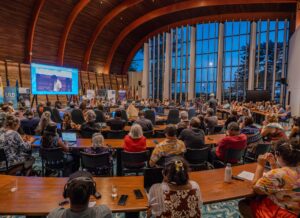
Pacific in transition evening, SPC auditorium, 03/26/2025, © Jean Michel Boré
Young voices committed to the climate
The evening started with a moving presentation on how young people in New Caledonia feel about climate change. Through drawings, CM2 pupils from the Marie Havet school in Ouémo, the Yvonne Lacourt school in La Foa and the Thio school group shared their vision of climate change. A video presenting the project was shown. This sequence highlighted an intergenerational perception that oscillates between hope and concern.
“It’s essential that we are involved in the decisions that affect our future. (…) We want to play an active part in devising solutions.” Dylan Leconte
Following this opening, two young people committed to defending their environmental heritage spoke eloquently. Their oratorical performances reflected a deep attachment to their territory. Georgina Sioremu, a Bachelor’s student in graphic and web design at the École du Design de Nouméa, and Dylan Leconte, a student in a preparatory class in economics and business at the Lycée Dick Ukeiwe, affirmed their desire to get involved in the dynamics of social and climatic transformation, and to be part of a movement of transmission and sharing.
“I can’t look away any longer, my mission is waiting for me. (…) We can all see the changes.” Georgina Sioremu
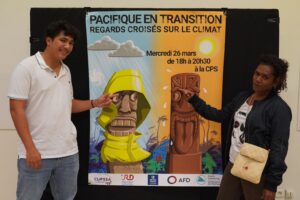
Georgina and Dylan in front of the event poster, SPC hall, 03/26/2025, © Maeva Tesan
Relive their performance on video and read their text in the appendix to this article.
Crossing disciplines to understand climate reality better
A panel of social science and climatology researchers then took the floor to share their work with CLIPSSA.
Through a rich dialogue, Dakéga Ragatoa, postdoctoral modeller of the impacts of climate change on agriculture and water at IRD, and Jérémy Guerbette, research engineer at Météo-France’s Direction interrégionale de Polynésie Française, highlighted their respective roles in CLIPSSA and their first results.
Climate simulations show possible future trends in several variables, such as temperature, wind, and precipitation. Modellers can then simulate the response of plants and crops to these changes.
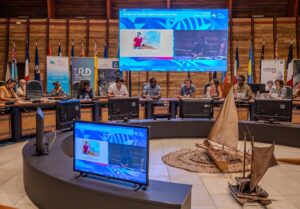
Panelists at the evening event, SPC’s auditorium, 03/26/2025, © Jean Michel Boré
Regarding the human and social sciences, Maya Leclercq, a post-doctoral anthropologist at IRD, and Samson Jean Marie, a doctoral student in anthropology and geography at EDP-UNC (Ecole doctorale du Pacifique de l’Université de Nouvelle-Calédonie) and IRD, presented the adaptation strategies developed by local communities in the four territories.
For example, some yam and taro growers in Futuna vary the distances between plantations each year to observe changes in yield. Similarly, on the southern island of Espiritu Santo in Vanuatu, farmers plant soft yam (a variety of yam) and sweet potato in the same field to protect themselves against cyclone damage. Anthropologists have discussed the limits of these strategies and the cultural and social resources mobilized to cope with the new climatic constraints.
The CLIPSSA project aims to pass on these scientific analyses to institutions, guiding public policy towards adaptation plans informed by realities on the ground.
In addition to interacting directly with the panellists in a question-and-answer session, the public shared their experiences of farming practices. Participants in the various surveys shared their experiences of weather-related hazards. At the end of the conference, the audience said they felt “inspired” and “hopeful”.
Screenshots and photographs of the evening polls, SPC’s auditorium, 03/26/2025, © Cléophée Montizon
The evening ended with a screening of extracts from the documentary Un paradis en péril, directed in 2022 by Jacques-Olivier TROMPAS (JADA Productions) in co-production with IRD. The CLIPSSA project team participated in the film by conducting interviews on the study of climate change impacts and the transmission of scientific results to public policies and communities.
Towards a shared future
Combining scientific insights and citizen testimonials, Pacifique en transition provided a better understanding of the region’s climate challenges. In addition to raising awareness, the event opened up prospects for dialogue and cooperation between researchers, citizens and institutions to build sustainable, resilient responses rooted in local realities.
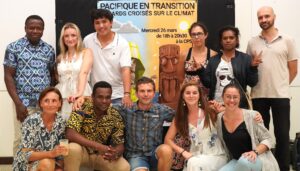
Speakers and organizers in front of the event poster, SPC hall, 03/26/2025, © Maeva Tesan
You can relive the evening in its entirety in the video below.
Appendices :
What future climate for New Caledonia?
Pacific in transition: perspectives on climate
- Link to the conference recording
- Powerpoint presentation of the conference
- Dylan Leconte’s text FR – ENG
- Georgina Sioremu’s text FR – ENG



